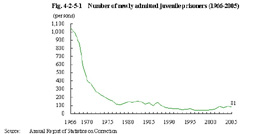| Previous Next Index Image Index Year Selection | |
|
|
1 Number and characteristics of juvenile prisoners Among newly admitted inmates, the number of those who were under 20 years of age at the time of admittance (including those who were over 20 at the time of admittance but were under 20 when receiving an indeterminate sentence; hereinafter referred to as "newly admitted juvenile prisoners") was over 1,000 in 1966, but decreased after that, remaining below 100 since 1988. In 2005, 81 juveniles (a decrease of three juveniles from the previous year) were imprisoned including five females.
Fig.4-2-5-1 shows the trends in the number of newly admitted juvenile prisoners since 1966. Fig. 4-2-5-1 Number of newly admitted juvenile prisoners (1966-2005) Among juvenile prisoners newly admitted in 2005 (those who were over 20 at the time of admittance but were 19 when receiving an indeterminate sentence are considered to be 19), 16 juveniles were aged 16 or 17 and 65 juveniles were aged 18 or 19. There were no juvenile prisoners under 16 at the time of admittance between 2001 and 2005.Among 81 newly admitted juvenile prisoners in 2005, one was sentenced to life imprisonment and three to imprisonment for a fixed term for over 10 years but 15 years or less; and regarding those sentenced to imprisonment for indeterminate terms, by the length of the maximum term, 42 were sentenced to imprisonment up to more than five years but 10 years or less, 22 to imprisonment up to more than three years but five years or less, and 13 to imprisonment up to three years or less. They were all sentenced to imprisonment with work. By type of offense, robbery was largest in number with 28 (two for robbery and 26 for robbery causing death or injury), followed by injury with 13 (one for injury and 12 for injury causing death), negligence in the pursuit of social activities with 10, and homicide with seven (Source: Annual Report of Statistics on Correction). |
